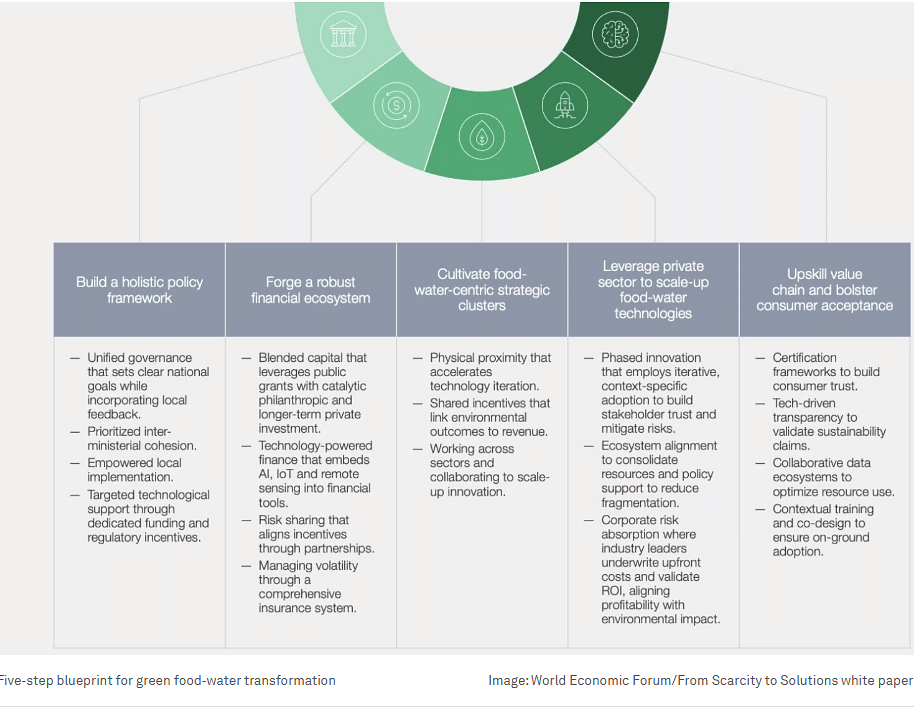Today, agri-food systems alone are responsible for 70% of freshwater use. By 2050, sustaining 9.7 billion people will require significantly more resources, even as climate change intensifies water scarcity, soil degradation and ecosystem collapse.
This convergence of limited resources and urgency places the food-water nexus at the centre of global leadership priorities, demanding timely action to rebalance humanity’s relationship with water.
Emerging economies are turning resource scarcity into a catalyst for ingenuity. Asia Pacific and the Middle East are key growth markets for green food and water technology, projected to reach $209 billion – nearly 45% of the global market – by 2030.
Learnings from China and the Middle East offer a blueprint for scalable, market-driven solutions:
- China, with 6% of the world’s freshwater and around 9% of the arable land, sustains 20% of the global population. Its efforts in tech innovations, such as high-standard farmland development, crop bio-breeding for new varieties, precision agriculture, and closed-loop circularity, have been an important driver in boosting farmer incomes tenfold since 2000.
- The Middle East, where 14 countries face extreme water stress, now produces 40% of the world’s desalinated water. Innovations such as solar-powered desalination and salt-tolerant crops are transforming deserts into productive landscapes and reducing reliance on groundwater.
Lessons learned from industry practices
The white paper, From Scarcity to Solutions: Food-Water Innovation in Asia and the Middle East, is a landscape analysis, examining 13 industry players across these regions and uncovers a more nuanced reality.
While 12 high-impact technologies are transforming food and water systems, their impact will remain limited without systemic support (Exhibit 1).

The journey of industry players highlights four recurring challenges:
- Fragmented innovation ecosystem: Disjointed regulations, scarce long-term funding and volatile startup pipelines remain critical barriers to scaling green solutions.
- Infrastructure deficits: Underinvestment in cross-sector and last-mile infrastructure (e.g. infield irrigation, digital connectivity) restricts the scalability of promising technologies.
- Economic misalignment: High upfront costs for advanced solutions such as bioengineered soil, combined with weak incentives, discourage farmers and small- and medium-sized enterprises from adopting sustainable technologies.
- Skills shortages: The effective deployment of advanced systems, such as internet of things (IoT) enabled irrigation, is constrained by a widespread lack of technical expertise across the entire food value chain.
These barriers persist even in markets with advanced technologies. Without addressing them, innovations remain isolated pilots.
5-point blueprint for green food-water transformation
Drawing on these insights and building on the learnings of the Food Innovation Hubs globally we distilled a five-point blueprint to accelerate the green transition in food-water systems.
1. Build holistic policy frameworks
Effective policy design hinges on transforming fragmented governance into an “innovation highway” – a seamless alignment of ministries overseeing food, water and environmental priorities.
China, while retaining separate ministries, bridges institutional silos through cross-agency task forces tied to national priorities.
The United Arab Emirates (UAE) reflects this by consolidating mandates under a single ministry, enabling the agile scaling up of food-water technologies without bureaucratic lag.
Success requires unified governance, prioritized ministerial cohesion, empowered local implementation and targeted support for key technologies.
2. Forge a robust financial system
Scaling green food and water innovations requires coordinated financial systems that fund research and development (R&D), de-risk adoption and engage diverse stakeholders.
China integrates government-led funding mechanisms, institutional financial tools and risk-mitigation frameworks.
The government allocates funding for strategic R&D and provides subsidies to support adoption. Financial tools such as green finance, satellite-based risk assessments and agricultural insurance expand credit access and stabilize farmer incomes.
In the Middle East, programmes such as Saudi Arabia’s NEOM and the UAE’s agri-tech incentive programmes combine sovereign wealth funds with non-financial support to develop next-generation agriculture solutions in arid and desert climates.
3. Cultivate a food-water-centric strategic cluster
Geographic clusters of innovators, industries, public institutions and value-chain stakeholders play a vital role in scaling water-smart agriculture and resilient water systems.
By co-locating actors, these ecosystems enable rapid prototyping, shared infrastructure and collaborative problem-solving, transforming isolated pilots into systemic impact.
The public sector can integrate cross-sector resources, while the private sector can drive sustainable stewardship across the supply chain.
Clusters thrive when physical proximity accelerates innovation and shared incentives link environmental outcomes with commercial returns.
China’s Qingshan Village exemplifies this model: through cross-sector collaboration involving non-governmental organizations, corporations, farmers, tourism businesses and local government, it achieved economic and environmental wins.
4. Leverage the private sector to scale water-food tech
The private sector plays a vital role in absorbing upfront costs – such as those related to IoT-enabled irrigation systems – and in addressing barriers – such as fragmented ecosystems and low trust among smallholders – by linking technology adoption with market access.
Success depends on three interdependent principles: phased innovation to build trust through iterative deployment, ecosystem alignment via public-private partnerships to consolidate resources and policy support and corporate risk absorption to validate returns and absorb early-stage costs.
Collaborative platforms such as the Food Innovation Hub leverage public-private partnerships to source, shape and scale market-driven food system innovation.
5. Upskilling value chain players and fostering consumer acceptance
Bridging the gap between producer capabilities and consumer demand ensures long-term adoption. Affordability, transparency and accessibility are interdependent factors that shape market adoption.
Four pillars underpin this transformation: certification frameworks to boost trust, tech-enabled transparency to validate sustainability claims, collaborative data ecosystems to optimize resource use and contextualized training to empower producers.
Case studies in the paper have illustrated how tailored training and digital platforms unlock market access and producer incomes. Meanwhile, bringing the latest technologies and methods to rural areas and enabling co-design empowers value chain players to adopt sustainable solutions effectively.
Impact multiplier
The food-water nexus is an impact multiplier for sustained and resilient economies. Work on systemic transformation has just begun, especially across emerging economics. The five-step blueprint provides a pathway to dismantle silos, align stakeholders and embed innovation into the fabric of food-water systems.
Humanity needs to rebalance its relationship with water. Now is the time to act and bring together a global movement – where investing in food systems means investing in water, transforming scarcity into shared abundance.
Explore the full whitepaper for a detailed analysis of 12 tech levers and dive into 13 industry case studies and a five-step blueprint.
Noopur Desai is the Programme Lead, Food Innovation Hubs at World Economic Forum. Carrie Zhang is the Associate Director at Boston Consulting Group






